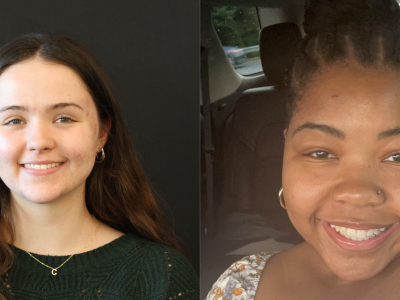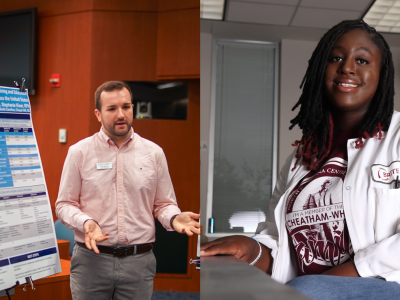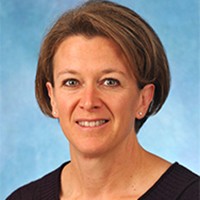July 15, 2020

Today, an estimated 700,000 people in the United States are living with a primary brain tumor. Members of the Shawn Hingtgen Lab at the UNC Eshelman School of Pharmacy are focused on curing the disease, specifically glioblastoma, one of the deadliest forms of brain cancer.
Recently, researchers in the lab published, “Generation and profiling of tumor-homing induced neural stem cells from the skin of cancer patients,” which details a promising approach to treating cancer that involves converting human fibroblasts (cells from the skin) into personalized induced neural stem cells (iNSCs) that actively seek out tumors and deliver cytotoxic agents, such as chemotherapy. The team has previously shown this approach works when starting with skin from normal mice and humans, but the ability to generate iNSCs from the skin of cancer patients has not been explored, until now.
In their new work, the researchers take an important step toward clinical application by generating the first iNSCs from skin biopsies of human patients undergoing treatment for glioblastoma, a highly aggressive brain cancer. Then, they investigated the efficacy and tumor-homing capacity of these patient-derived cells. Their data showed that not only can tumor-homing iNSCs be generated from the skin of cancer patients, but that the approach is highly effective at suppressing the tumor growth of human tumors in mice.
Here, Shawn Hingtgen, Ph.D., and Principal Investigator Andrew Buckley, Ph.D., postdoctoral researcher, share their thoughts on the progressive research:
Question: How does it feel to see your work being translated into tissue from human cancer patients?
Shawn: It is very rewarding and exciting to see the tumor-homing iNSC work move into cancer patient tissue. The work has built from mouse skin, to the skin of normal human patients, so this was the real test. We needed to be able to create the cells from cancer patients, otherwise the approach had no future. Thankfully, our results showed this was possible. We are also very grateful to the cancer patients who were so willing to donate their tissue for the studies. Without their amazing generosity we could not have advanced our work and take these key steps towards clinical testing.
Andrew: The ultimate goal is that the therapy is refined and made accessible to help patients. That would be a great way to see the project play out.
Q: What would you say to individuals who are affected by glioblastoma about this progress?
Shawn: We would like to let brain cancer patients know these results show enormous promise, but unfortunately still have a longways to go before we can launch first-in-human studies. We showed that we can make tumor-homing iNSCs from the skin of cancer patients from the first time, which was a big step. Equally important, we showed these cells home to tumors and kill human cancer that was implanted in the brains of mice. Key studies to confirm the efficacy of this approach. However, the next steps are to move this technology into human patients, steps that are expensive and take time. We have to establish a reproducible process for making the cells, we need to show they are safe in using well-defined studies set forth by the FDA, and we need to put all the moving pieces in place to launch a clinical trial. These steps all take time, unique expertise, and a significant amount of funding.
Q: What first inspired you to focus on glioblastoma research?
Shawn: My passion for brain cancer research comes from two sources. First is the patients. Brain cancer is one of the most aggressive types of tumors. Patients typically survive a little over one year after diagnosis and treatment. Sadly, there have been few improvements in treatment for decades. There simply has to be a better way. This clear need has driven my passion to find better treatment options for brain cancer. A passion that has been further fueled by discussions with patients and their families. You cannot walk away from those amazing people without feeling the need to help. I believe I can do this best by working to create new therapies. This leads into my second inspiration for focusing on glioblastoma. I focus on it because the iNSC technology fits well with the gaps in care. Glioblastoma is highly invasive, often spreading through the brain. This makes surgically removing the complete tumor a big challenge, and allows small cancer spots to “hide” from standard chemotherapy and radiation. However, iNSCs are designed to seek out tumors and deliver therapies right into these distant invasive islands of cancer. To me, this directly aligns the strengths of iNSC therapy with the major hurdles in glioblastoma therapy, meaning the technology really has a chance for success and gives hope for improving the lives of brain cancer patients.
Q: How did support from the Eshelman Institute for Innovation propel this work forward?
Shawn: Support from the Eshelman Institute was vital to this entire project. The work was funded by a Tier 3 Eshelman grant, which ultimately meant speed. When we pitched the idea, we had preliminary data but were too early to receive funding from the NIH or other large grant agencies. This meant we would have to continue to slowly roll out studies as we didn’t have funds to launch large scale work. Glioblastoma patients don’t have time for us to be slow, and we felt a strong sense of urgency as well. The EII funding gave us the resources to be bold and aggressive. It dramatically accelerated our work, allowing us to begin enrolling patients, collecting samples, and launching our tests. Although the studies never go fast enough for us to be fully satisfied with pace, it’s very gratifying to look at the results of the paper and say, ‘we accomplished what we had proposed, even better, the concept worked.’
Andrew: The Eshelman Institute has a great reputation for forward thinking, and they have shown willingness to back good ideas. Everyone knows how long national grant funding can take to get, so this helped advance the research much quicker.
Q: What keeps each of you motivated in the lab?
Shawn: To me, the answer is simple: cancer patients and innovation. Our work in the lab has allowed us to interact with many different cancer patients. Both actively undergoing treatment and survivors. Their stories are so powerful. It is all the motivation I need to continue trying every day to develop treatments that are more effective and safer, then to move these towards patient trials. I have also found my passion in innovation. Not only working with our fantastic team to develop better treatments but launching wonderful new collaborations to invent new approaches that have never been tried. Paving new ground can be frustrating because you rarely have a path to follow, but when you see that first results showing new concepts have promise, it’s an amazing feeling. Thankfully, my passion for innovation has aligned with the goals of The Eshelman Institute, and their support has allowed us to move several of the innovative concepts from idea to reality. It’s exciting to work at a place where your primary limitation is simply your creativity.
Andrew: Not being satisfied with what I already know. There is so much to learn, and you never know when knowledge of something is going to be useful. Shawn has done a great job of building a cross-functional lab and he has recruited people from diverse scientific backgrounds. It is really motivating to go into the lab when you have all of those perspectives and experiences play off of one another and generate new ideas and experiments to try that you maybe wouldn’t have come up with on your own.
Q: What are your hopes for the future of this work?
Shawn: Again, my hopes all come back to the patient. Our goal is to launch first-in-human trials and see the personalized iNSC therapy significantly improve the lives of brain cancer patients. Thankfully, we have a wonderful multi-disciplinary team of clinicians, scientists, and so many others working together toward this goal. I’m excited to see what the future holds, and grateful for the opportunity to potentially make a difference in the clinical care for patients suffering from lethal diseases like glioblastoma.
Andrew: The ultimate goal is that the therapy is refined and made accessible to help patients. That would be a great way to see the project play out.
Researchers on the project include: Andrew Buckley*, Shaye B. Hagler*, Vivien Lettry, Juli R. Bagó, Spencer M. Maingi, Simon Khagi, Matthew G. Ewend, C. Ryan Miller, Shawn, D. Hingtgen
*Authors contributed equally
Latest News

Early Assurance Program inspires students from small towns

Rural Health Scholars dream to make a difference


